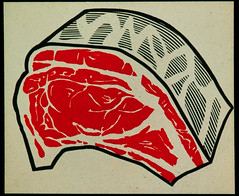There’s no denying that the weather has changed and that we’re firmly in autumn now. It had gotten cold early this year but the last few weeks have been dry and sunny which is rare this late in the year. I had salvaged the last of my tomatoes a few weeks ago and let them ripen in the house but now they’re gone and I’m starting to cook differently to reflect the change of seasons.
My homebrew club had our annual competition yesterday and we went to the Green Dragon afterwards (both of which I’ll write about separately) to enjoy some great beers and fabulous food. It was a hectic day and today I’m ready for something a little easier so I planned a simple meal that reflects the seasons pretty well.
My wife had picked up a small pork loin roast and wasn’t sure if I wanted to cut it into chops or roast it whole. (Most loin chops are cut too thin and your best bet is usually buying a good sized loin roast and cutting them yourself. More proof that real butchers are going away and are being replaced by less educated meat cutters. Find a good local butcher and buy from him. They’re a dying breed and nobody can tell you more about how to cook a cut of meat than a real butcher, but I digress.) Because I didn’t want to get too involved, I’ve opted for the easy way out: pork loin roast.
Roasts are easy on the cook, and, when done right, they’re tough to beat. Pork is considerably leaner that it used to be and can dry out easily, so I normally brine my pork roasts for a few hours before cooking them, which helps to keep them moist. The apple crop is abundant now, so cooking a few apples on the side is a natural, especially given the natural affinity of pork and apples. I chose Pink Lady’s which hold up well to cooking and have good acidity. I sautéed them in olive oil and butter with a little cinnamon and finished them with some maples syrup to balance their natural tartness.
For a starch, I opted to use up the loaf of French bread I have sitting around that’s gotten stale by making a panade. A panade is, for lack of a better description, a savory bread pudding, although it lacks the cream and eggs of the dessert type of bread pudding. It’s another one of the incredibly resourceful uses for dried bread that exist in most types of peasant cooking. The panade I’m making is loosely based upon the recipe in Judith Miller’s Zuni Café cookbook. My panade is a combination of dried bread, sautéed onions, wilted Lacinta kale, parmesan cheese, chicken stock, and olive oil. The ingredients are cooked separately and then combined roughly in layers in a casserole. The whole casserole is filled to the brim with chicken stock and then put in a moderate oven to meld in to something that is far more than the sum total of its parts. If you use a hearty enough mix of ingredients, you could easily make a light supper out of it, but it’s also a fantastic side to roasted meats.
I have a fair amount of homebrew kicking about but I also have a plethora of commercial beer right now, so I opted for something commercial. Pork and pilsner is a classic match and I have some Pilsner Urquell, which is the original pilsner style beer. Luckily they now make it in cans which ensure that the beer isn’t light struck the way it often is in green bottles (which means it’s not skunky). Cans still have stigma attached to them, but they’re actually the package of choice for beer since they’re more airtight and don’t let damaging light in. There’s no metallic taste to beers cans anymore so there’s really no downside. I had some Sierra Nevada Celebration Ale in reserve just in case but it doesn’t get any better than pork and pilsner? The hop bitterness and crispness of the pilsner are the perfect foil to the sweet pork and apples and the slow cooked richness of the panade. Does it really get much better than pork and pilsner? Not tonight it doesn’t.
Sunday, November 11, 2007
Roast Pork Loin and Pilsner
Posted by
Bill
at
7:57 PM
![]()
![]()
Labels: panade, pilsner urquell, pork loin chop, roast pork
Subscribe to:
Post Comments (Atom)

No comments:
Post a Comment